Bolivia - Part 2 of 2: Salar de Uyuni and 4x4 Offroading Andes Altiplano to Chile over Hito Cajón Mountain Pass
After visiting the city of La Paz, an Aymara village with a ride on lake Titicaca on a traditional reed boat and Tiwanaku (see Part 1), we travel to Uyuni for a epic trip driving across the Salar de Uyuni salt flats, staying in salt hotels and a off-road 4x4 multi-day trip across the altiplano of Andes mountains and Atacama desert into Chile.
Here is a map of this part of our trip.
December 28, 2022
10:30 AM
Uyuni, Bolivia (20.4° S, 66.8° W, altitude 12,024 feet)
We took a 7:30 AM Boliviana De Aviación flight out of La Paz El Alto reaching Uyuni Joya Andina (Jewel of the Andes) airport at 10:30 AM with a one and a half hour layover at Cochabamba. There are cheap but comfortable overnight buses with sleeper seats from La Paz to Uyuni as well that many travelers use instead.
It had taken a very long time for us to clear immigration while getting into Bolivia (that story is here). Going by that experience, I decided to play it safe and woke everyone up at 4 AM. It takes only half an hour to get to El Alto airport from our downtown La Paz hotel and we were at the checkin desk by 5:00 AM. The Boliviana De Aviacion agent at the desk got a bit confused and asked where our guide was. I told him we have no guide. He then assigned another Boliviana De Aviacion person who checked on us periodically and made sure we get on the 7:30 AM flight.
During final approach at Uyuni, we got our first glimpse of the immense Salar de Uyuni salt flat that is the size of the country of Lebanon. After years of dreaming about visiting it some day, we were finally here!
They had confiscated our last aerosol of Lysol ("fire hazard") but otherwise Boliviana De Aviacion's service and hospitality were outstanding. Once again we experienced the warmth of human interactions with Bolivians, something very different from paid-to-be-nice north American and western-European staff.
We collected our luggage and headed to the airport exit. We had already booked airport transfer to our hotel - the world-famous Hotel Luna Salada de Sal & Spa. The driver of a Toyota Land Cruiser was waiting outside with a placard and we were on our way on the first of many trips between Hotel De Sal Luna Salada and the town of Uyuni.
There is some sort of a gated security checkpoint (locals use the word "Control") on the way out of Uyuni, or perhaps its a toll plaza. Either way, the gate is manually operated by the person inside the booth by putting her arm out to a lever on the outside wall. The lever is connected by wire to the gate. The attendant has to operate the lever for every vehicle that passes through. From what I saw, this requires strength.
Hotel De Sal Luna Salada is half an hour away from Uyuni airport. It is reached by driving northwest from the airport on Bolivia Ruta F30 and making a left onto a dirt road from Colchani. Eerily quiet and deserted with gift shops mostly closed, we were probably seeing yet another part of the world where COVID-19 took its toll on local tourism industry.
Hotel De Sal Luna Salada: the hotel made of salt
Hotel De Sal Luna Salada was high up on our bucket list ever since The National Geographic posted this video in January of 2015. A unique hotel at a unique location on the planet, almost everything in the hotel is made of salt, including tables, chairs, floors and even walls.
Natgeo coverage of Hotel Luna Salada
We eventually see a sign for the hotel on the dirt road from Colchani. Taking a right turn as the arrow says leads to another dirt road which climbs up a hill at the top of which we finally see the hotel.
We walk into the lobby. Indeed, the floor, walls, columns and even the couches and tables are all made of salt. The Salar de Uyuni is visible right outside the windows. It is totally unlike any hotel we have checked into so far.
The hotel is huge. Our family suite, the biggest and best accommodation the hotel offers, was at the other end. It is a 10-minute walk up two flights of stairs along long corridors.
Fortunately, we did not have to drag our luggage at the hotel's altitude of 12,000 feet. The assistance of the bellhop was welcome and worth generous tipping!
On the way to our suite there are series of lounges and cosy open spaces to sit down and hang out overlooking the Salar de Uyuni. The floor continues to be granular salt with laminate walkways laid on top. Walls and columns are built of compressed salt bricks secured with salt mortar.
Hotel De Sal Luna Salada is beautifully decorated all over with traditional Bolivian artefacts. Along with earthenware and metalware, we spotted llamas and alpacas made of reed. We had seen such artistic work of reed far away on the shores of lake Titicaca where they make reed boats (see Part 1).
The family suite at Hotel De Sal Luna Salada is practically a whole house with its own access hallway, two bedrooms and spacious family and living rooms.
Colchani
Things have evolved a bit now. There is a cooperative that manages salt gathering, processing and sales. Machines are used to process the salt, including iodization. Transportation has improved enough for shipping the salt out across Bolivia and internationally, Brazil being a top destination.
We toured a salt factory in Colchani and learned a few things.
- The salt in Salar de Uyuni is at least 700 feet deep in the center, though the true depth is unknown and a lower depth of 400 feet is cited often.
- The largest salt flat in the world, the Salar covers an area of over 4,086 square miles.
- Of the at least 11 billion tonnes of salt in the Salar, 25,000 tonnes are extracted and processed every year at Colchani.
- There are 11 layers of salt ranging from 6 to 60 feet deep each. The top layer is around 32 feet.
- Rainwater results in salty brine collecting between the layers. The dark bands in blocks of extracted salt represent rainfall.
- Evaporating salt lakes 40,000 and 12,000 years ago left behind concentrated minerals in the Salar, including potassium, boron, magnesium and lithium.
- Salar de Uyuni by itself contains over half of the planet's lithium. Along with Salar del Hombre Muerto, Argentina and Salar de Atacama, Chile, 75% of the world's lithium deposits are in the salt lakes of the Andes altiplano.
- Compressed salt bricks are used for construction, including other salt hotels and buildings around the Salar.
There are some mineral rocks from the area also on display at the salt factory. They contain Pyrite (FeS2), a mineral that resembles gold, often referred to as "fool's gold". Plastic-wrapped pieces of rocks are available for purchase as souvenirs, as are little bags of salt produced in the factory and hand-made sculptures of salt.
What really is the Salar de Uyuni?
According to National Geographic, "Bolivia’s Salar de Uyuni is considered one of the most extreme and remarkable vistas in all of South America, if not Earth. Stretching more than 4,050 square miles of the Altiplano, it is the world’s largest salt flat, left behind by prehistoric lakes evaporated long ago. Here, a thick crust of salt extends to the horizon, covered by quilted, polygonal patterns of salt rising from the ground.
The Star Wars Connection
Star Wars: The Last Jedi (Episode VIII) (2017) introduces us to the icy planet of Crait far far away. Crait is the site of a Rebel base. "Originally a mining installation, the Crait outpost was transformed into a fortress by anti-Imperial insurgents bankrolled by Alderaan’s Bail Organa. The Rebellion abandoned the base when a change in Imperial patrols endangered it, though Leia Organa and her friends fought a brief skirmish against the Empire there. Leia then tucked Crait’s coordinates away in a file she kept in case of emergencies – a precaution that would one day prove a lifeline for her Resistance", says the official description of Crait.
The Salar de Uyuni was the shooting location for Crait.
Volcán Thunupa (Tunupa Volcano) and Mummies of Coqueza
After lunch at Colchani, we drove straight into the white wonderland of Salar de Uyuni in the direction of Tunupa. We struck luck on the way and found an area of shallow standing water not too far from Volcán Thunupa. Water famously turns Salar de Uyuni into a mirror which becomes the planet's largest mirror when a thin water layer covers all of it after rainfall.
We continued to drive up to the trail head. There are some nice views of Salar de Uyuni from the way up. It was all empty and barren with only us around.
Las momias de Coqueza: the mummies of Coqueza (The Cave of the Mummies)
Grocery of the Mums of Coqueza
A sliver of light comes in through a hole in the rock covered with a grill. A Chinchilla peeks at us from outside.
There are chambers cut into rock. In these chambers there are mummified remains of six departed souls in fetal positions. They have been there for over 500 years, wrapped in straw, leaves and blankets. They have not been disturbed since being put there. Hair, clothes and positions are untouched. There is no odor other than the musty smell of an old cave.

One of the chambers has mummies of an adult woman and two children. Looking at the kids is particularly heart wrenching. Who knows what catastrophe befell them!
The mummies are surrounded with earthen jars, plates and stuff for them to use when they are reborn. On the floor in front of the mummies, there is a fireplace and bowls. People leave wine, food and money (and cigarettes!) for the departed. In Andean tradition, this cave is not a memorial, its a continuum.
Sunset over Salar de Uyuni
Huge Natural Crystalline Patterns on Salt Crust
There are these huge formations across the salt flats that form naturally when water evaporates. They are big enough for two of the usual 4x4 SUVs to fit easily into their diameters. The same patterns are seen on a miniature scale on salt crystals.
December 29, 2022
8:30 AM
A country in turmoil
Protests Turn Violent in Bolivia Amid a Political Crisis
We were supposed to be picked up at 8:30 AM by Nelson. We had our breakfast, packed up and arrived at the lobby of Hotel De Sal Luna Salada ready to check out and leave. It was then Nelson called my phone and informed us he will be a bit late since there is a gasoline shortage and all local pumps are out of gas, and he has to to get gas from somewhere else. The reason? Bolivia had gone into a political turmoil and violent protests had broken out following the arrest of Santa Cruz opposition governor Luis Fernando Camacho for whom prosecutors were seeking pre-trial detention in connection to a prior political unrest in 2019. Protesters, calling a "general strike", were blocking roads, burning cars and tires, hurling fireworks and clashing with police in Santa Cruz. The police were responding with riot control measures, starting with tear gas.
We had just managed to leave Peru a couple of days ago under similar circumstances of violent demonstrations. Looking at live news reports (BBC News covered it a day later, as did Reuters), we started to wonder if Bolivia would spiral out of control and whether we should bail out to Chile right then. However, the part of Bolivia we were in was so lightly populated and the people so nice, it was hard to imagine Santa Cruz-style violent conflict and fires burning here. Ultimately we decided to stick to the plan as best as circumstances allow. In hindsight, this was the correct decision given the epic few days we would spend next.
9:30 AM
Luz, Nelson and the folks at Expediciones Mammut did find gas somewhere and sent their Japanese colleague Masayuki-san in a Toyota Tundra to pick us up from Hotel De Sal Luna Salada. We headed to their office on Av. Ferroviaria (Ruta Nacional 5) in Uyuni half an hour away. Masayuki-san's Tundra did not even bother to take the dirt road back to Ruta F30 but cut diagonally across open terrain and climbed up on the highway.
We had a bit of time at the Mammut office while they figured out logistics for the next steps of our trip given the political situation in Bolivia. Taking a stroll down Av. Ferroviaria, we come to the intersection with Av. Avaroa at the center of which is a large sculpture of soldiers with guns. This is the Monument to Soldiers in Uyuni in tribute to servicemen who fought in the 1932-1935 Chaco War (Guerra del Chaco) between Bolivia and Paraguay.
Further west at the next intersection with Av. Ayacucho next to the Infantry Regiment 4 ( RI-4 ) "Loa" (Regimiento LOA), there is a big bustling bazaar-style marketplace with rows of stalls selling a myriad of goods from bluetooth speakers, clothes, fish, vegetable, fruits to handicrafts. I picked up a pack of peanuts to munch on.
Bolivia's Train Cemetery: The Great Train Graveyard at Uyuni
11:21 AM
The rail graveyard at Uyuni is among the strangest places we have visited across the world.
On Nov 20, 1890 Bolivian President Aniceto Arce rode a train to a brand new Uyuni station inaugurating the nation's first railroad to transport and export minerals. The trains moved much mineral between Uyuni and the Pacific port of Antofagasta until the Chile vs. Bolivia+Peru war of 1879-1884 (War of the Pacific, Guerra del Pacífico) resulted in Bolivia losing Antofagasta to Chile. Antofagasta was subsequently incorporated into Chile’s Department of Atacama, and the railroad had nowhere to go. Today the abandoned station and rusty remains of trains are immensely popular with visitors.
Return to Salar de Uyuni
We headed back to the Salar from graveyard of trains to continue the first of our three days of offroad 4x4 driving across the Bolivian Andes altiplano.
Ojos de Agua - Eyes of Water
Monumento al Dakar: Dakar Monument
12:56 PM
The route of the eighth stage of the 2015 Dakar Rally was from Salar de Uyuni to Iquique, Chile. The drivers flagged off in the Salar on Jan. 11, 2015.
A monument made of salt in the middle of the Salar commemorates the occasion not too far from Ojos de Agua.
Plaza de las Banderas: Flag Square
12:59 PM
Close to the Dakar monument, there is an elevated platform made of salt with salt steps leading up to it. There are flags of many countries fluttering on poles on that platform, often with flags of different countries on the same poles. It is a custom in the Salar for visitors to place their country flags at the Plaza de las Banderas.
Other than at least two of our own Old Glory, it was exciting to see the flag of Ukraine, the bravest of countries at this time, fluttering high and proud sharing a pole with Venezuela and Panama. We spotted the colors of Ukraine on at least two other poles as well.
Hotel de Sal Playa Blanca, Salar de Uyuni
The original old abandoned Hotel Palacio de Sal
13:07
In the mid 1990s, a hotel named Palacio de Sal was built entirely of salt in the middle of Salar de Uyuni. Featuring 12 double rooms and a shared bathroom with no shower, the ensuing throngs of tourists caused issues with sewage collection which was a manual process, resulting in a mismanaged environmental pollution crisis that forced the hotel to cease operation. It is not possible to spend the night at the hotel from 2002.
The old hotel building is now called Hotel de Sal Playa Blanca and used as a place for having lunch while on tour of the Salar. That is exactly what we did. The salt sculptures in the hotel are still impressive.
Stuck on the Salar de Uyuni Salt Flats


We were in an unbelievable situation of being stranded in the Salt Flat because the Salar de Uyuni immobilized three capable rugged 4x4 offroad vehicles.

I did check with the Mammut team later that evening and was told they and the three vehicles were all doing fine. All in all, we had an extra, unscheduled and exciting experience and came out with a great story to tell.
Funny Pictures at Salar de Uyuni: Extreme Perspective Photos
Salar de Uyuni is world famous for extreme perspective photography. I had tried to take a couple of such photos the previous day, but Nelson took these far better pictures.
Isla Incahuasi: The "House of the Incas" Island
Hotel de Sal Cruz Andina
20:00
We spent the night at the relatively new Hotel de Sal Cruz Andina which is located on Tambo Loma island off the south shore of Salar de Uyuni just over a mile southeast of the town of Colcha K. It is close to the military base of Regimiento de Infantería 27 Antofagasta (Regimiento Legionarios).
December 30, 2022
We get ready, pack up, have breakfast at Hotel Cruz Andina and hit the road. We would leave the Salar de Uyuni behind and head off to our offroad 4x4 drive across the revered Andes altiplano into Chile the next day.
Julaca, Bolivia (20.9112° S, 67.5649° W, alt. 12,500 feet)
10:48 AM
We drive generally east on Bolivia Ruta Nacional 5 towards Rio Grande. Our first stop is the tiny hamlet of Julaca.
There are rail tracks going off into the horizon to the west into Chile.

Estancia Chakha: Wildlife Valley and Flat Tire
Villa Alota
12:27 PMMeeting Adam Palowski - the biker who rides across the world
 |
| Adam Palowski's Motorcycle in Villa Alota, Bolivia |
Lunch break over, we got out of Villa Alota back on Route 701 driving west towards Avaroa to greet Volcán Ollagüe.
Volcán Ollagüe
Laguna Chulluncani
Laguna Hedionda (Stinking Lake): Suri (Andean Ostrich) and more Guanaco
Laguna Cachi
Laguna Kara
Leguna Kara (map) sits at an altitude of 14,846 feet in the desert highlands of Bolivian Altiplano nestling under snow-covered peaks of Cordillera Occidental range of central Andes. Flamingos walk on it. The landscape around it gets even more rugged and desert-like than the lakes on our way here. Desierto de Siloli lies ahead.
Desierto de Siloli
 |
| Árbol de Piedra: Stone Tree at Desierto de Siloli |

Reserva Nacional de Fauna Andina Eduardo Avaroa: Eduardo Avaroa Andean Fauna National Reserve
Laguna Colorada (Red Lagoon)

Latitudes Hostal, Huyajara
 |
| Courtyard of Latitudes Hostal |
 |
| Reception desk, Latitudes Hostal |
 |
| Generator at Latitudes Hostal |
 |
| Solar Panels for power and Satellite dish for internet at Latitudes Hostal |
 |
| Hallway to the left of the kitchen, Latitudes Hostal |
 |
| Numbered rooms around Dining area, Latitudes Hostal |
December 31, 2022

Geotermas Sol de Mañana
At an altitude of 16,092 feet in the rugged desert of the Bolivian Andes Altiplano lies the 2,500 acres of Sol de Mañana Geothermal Area (map) with furiously boiling mineral rich mud in scary cracks on the ground, intense jets of vapor and geysers shooting up hot water sometimes to over 160 feet.

Termas de Polques: Hot Springs on Laguna Chalviri at Salar de Chalviri

Desierto Salvador Dalí (Valle de Dalí)
07:56 AM
 |
| Salvador Dalí's famous 1931 Surrealist Painting "The Persistence of Memory" (fair use) |
South of Termas de Polques, the vast expanse of Salvador Dalí Desert at an altitude of 15,289 feet is inside the Eduardo Avaroa Andean Fauna National Reserve.
 |
| Salvador Dalí Desert |
The Desierto Salvador Dalí in Bolivia, located on the Andes Altiplano, is a surreal, dreamlike landscape named after the famous artist Salvador Dalí because its colorful, bizarre rock formations resemble his paintings.
 |
| Salvador Dalí Desert |
Geologically, it is part of the Eduardo Avaroa Andean Fauna National Reserve, formed by volcanic activity, erosion, and mineral deposits, creating vibrant reds, yellows, and whites.
 |
| Salvador Dalí Desert |
Historically, the region was shaped by ancient volcanic eruptions and glacial movements.
 |
| Salvador Dalí Desert |
Culturally, it is tied to the indigenous Aymara and Quechua peoples, who have lived in the Andes for millenia, respecting the land as sacred.
 |
| Salvador Dalí Desert |
Local folklore tells of spirits and deities inhabiting the mountains and deserts, with legends of hidden treasures and mystical beings guarding the harsh terrain.
 |
| Salvador Dalí Desert |
The area is also home to unique wildlife, like flamingos, vicuñas, and viscachas, adding to its otherworldly charm.
 |
| Salvador Dalí Desert |
The desert really has nothing to do with the legendary artist who lived in Spain and California having never set foot in Bolivia.
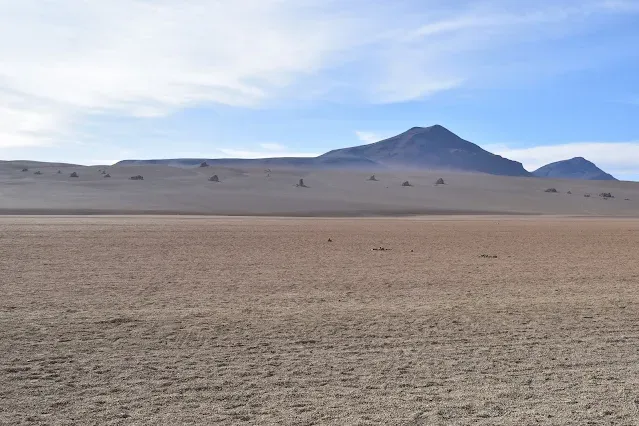 |
| Salvador Dalí Desert |
It is named after Salvador Dali because of the extremely dry rugged 27,000 acres of mountain desert vistas that apparently remind people of paintings by the genius of Surrealism.
 |
| Salvador Dalí Desert |
Laguna Blanca (White Lagoon) and Laguna Verde (Green Lagoon)

Volcán Licancabur: NASA Mars Mission on Earth

Hito Cajón (Portezuelo del Cajón) Mountain Pass
Bolivia - Chile International Border Crossing
Bolivian Customs / Immigration
- The Bolivia - Chile border here is also the border of Bolivia's Eduardo Avaroa Andean Fauna National Reserve. The first control is the exit gate of the National Park where we get exit stamps on our tickets and are repeatedly reminded to retain the tickets.
- The second control before Hito Cajone is a building where we fill out immigration / customs exit forms and stand in a queue. The officer there checks our canceled Park tickets, verifies our exit forms for correct passport numbers and lets us go.
- Migración Bolivia: Bolivian Immigration Control at land border at Hito Cajone pass.

After at least four days of rough offroading, we celebrated being back on an excellent paved road. And we were on our way to the Chile Immigration and Customs office and then San Pedro de Atacama!
Chile Customs / Immigration
The Wild Donkeys of Atacama Desert
San Pedro de Atacama, Chile
San Pedro de Atacama is a tourist town of around 2,000 permanent residents at an altitude of 8,000 feet. It is approximately 40 minutes west of Chile's Hito Cajon immigration complex on Ruta 27 (map).
San Pedro sits in the lap of Volcán Licancabur persisting with vistas of Atacama desert, salt flats, volcanoes, geysers, hot springs and lakes from across the political border. The Los Flamencos National Reserve to its east is essentially a southern expansion of Bolivia's Eduardo Avaroa Andean Fauna National Reserve. The nearby Valle de la Luna (Valley of the Moon) is popular for its unusual rock formations, a huge sand dune and pink-streaked mountains.
The ancient town is continuously inhabited since prehistoric times. It is a candidate for UNESCO world heritage site status. "Subsequential groups left circular tombs, adobe houses with conical roofs, a ceremonial center of the Atacama people (under the influence of the Tiwanaku empire), defensive and industrial works by the Inca and the colonial local church", say UNESCO. The R. P. Gustavo Le Paige Archaeological Museum showcases ancient cultures of the Atacama. More recently, San Pedro was a major town on the Inca empire's 19,000 mile Qhapaq Ñan road network that connected Argentina, Bolivia, Chile, Colombia, Ecuador and Peru.
San Pedro has special importance for modern astronomical science. The Atacama desert is the driest place in the world with no precipitation for decades in some places. The high-altitude pollution-free dry and calm air results in the clearest night skies seen from Earth. A host of telescopes and observatories have been looking at the heavens from around San Pedro, including ALMA (Atacama Large Millimeter/submillimeter Array) observatory that is part of the Event Horizon Telescope which recently took the first photographs of the supermassive black hole in the center of our galaxy. ALMA is currently the largest astronomical project in existence.
Other than telescopes, San Pedro's Museo del Meteorito three blocks from city center features a fascinating collection of meteorites combined with the story of life on Earth, our solar system and the cosmos.
The Bolivia to Chile Transfer Minibus makes two stops in San Pedro. The first stop is at the Terminal de Buses (map) where some folks got off to connect with other buses. We disembarked at the second stop at Plaza TourisTour at intersection of Ignacio Carrera Pinto and Caracoles (map). From there it was a six-minute walk up Caracoles and left into Tocopilla to our Hotel La Cochera.
I had many great conversations with Carlos who was managing La Cochera at the time. Of the many interesting stories I heard from Carlos, he has hitch-hiked his way across the legendary Carretera Austral, Chile's trans-Patagonia Route 7. We have a deal with him: when we return to Chile drive the Austral, Carlos is coming with us!
After checking in, we headed out to find some lunch, ending up in a pretty restaurant named Casa de Piedra Atacameña. We were led across the fiery grills and up the stairs to the 2nd floor with a straw roof (rain is not an issue here) and distinct Atacameño ambience. The food was delicious!
We then strolled around a bit at random, picking up some essentials, a traditional llama wool scarf and simple souvenirs. Interestingly a local money exchanger agreed to exchange our remaining Boliviano to Chilean Pesos, probably at a pretty bad exchange rate but we were happy to swap out the little unused Boliviano we had.
There is something about sowing machines in shops on the altiplano. A classic singer machine was displayed in a minimarket, perhaps for sale.
We headed back to our hotel at dusk to get some dinner and be ready for the famous Atacama astronomical tour.
Astronomical Tour at San Pedro de Atacama
We had no prior reservation for an astronomical tour. It was a challenge to find one operating on the night of New Year's Eve with only a few hours left before nightfall. With great effort and a lot of convincing ("We are coming from Washington, DC to tour with you, so please please ..."), Tour Astronómico por Sol Andino (Astronomical Tour by Sol Andino) agreed to take us. We walked to the pick-up point of Sol Andino Expediciones office at Caracoles 362 at 9 PM. The tour guide and assistant met the four of us there along with just one other couple, and we walked together to Plaza TourisTour (where we had gotten off the Bolivia-Chile Transfer minibus earlier in the day) to board their van.
We met Laika the Dog on our way. Apparently this Laika of San Pedro de Atacama hangs around every night to welcome stargazers like us. Laika is, of course, named after the legendary Soviet space dog - a stray mongrel from the streets of Moscow who became the first animal to orbit planet Earth and sadly gave her life in pursuit of the science of astronomy.

Our guide then pulled out a laser pointer and we listened to him awestruck as he pointed out clusters, superclusters, nebulae, planets and constellations. It was like we were in a real-life planetarium show.
It was a mesmerizing couple of hours as our guide and his assistant then pointed the telescopes to different objects and we put our eye on the eyepieces of wonder. Distant gaseous nebulae and galactic clusters to the rings of Saturn revealed themselves with a clarity only possible from the Atacama.
Laika the (Chilean) Dog loves to sit below telescopes!
January 1, 2023
San Pedro de Atacama Main Plaza
08:42 AM


There was a contraption hanging from the electric meter on the boundary wall of the church. It appears to be some sort of a cell phone charging station for public use.
The streets around the central plaza were deserted. And every Chilean street dog we saw was huge and insanely beautiful!
Calama, Chile - Driving the Ruta del Desierto
Driving Chile Route 23: Ruta del Desierto (Desert Route) On Atacama
Acknowledgements
We owe the Bolivia part of our trip to a couple of outstanding people and their businesses. I am not affiliated with these businesses and this is independent opinion.
My friend Juan Carlos Cardenas is the boss of Pukina Travel based in La Paz: pukinatravel.com
Juan's friends Luz and Nelson are now my friends too. They run Mammut Expeditions from Uyuni: expedicionesmammut.com
The End




















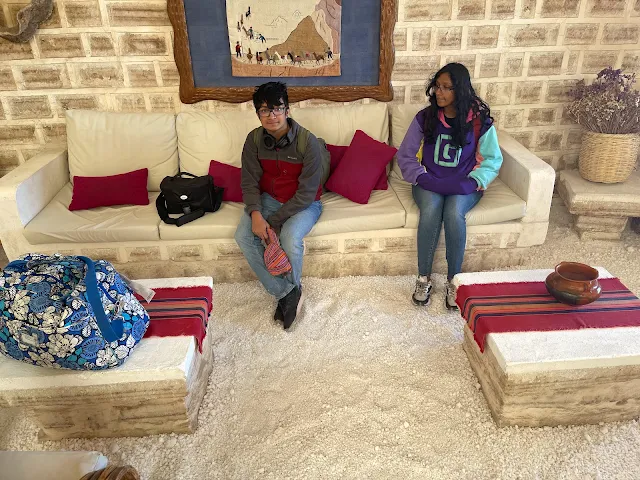




























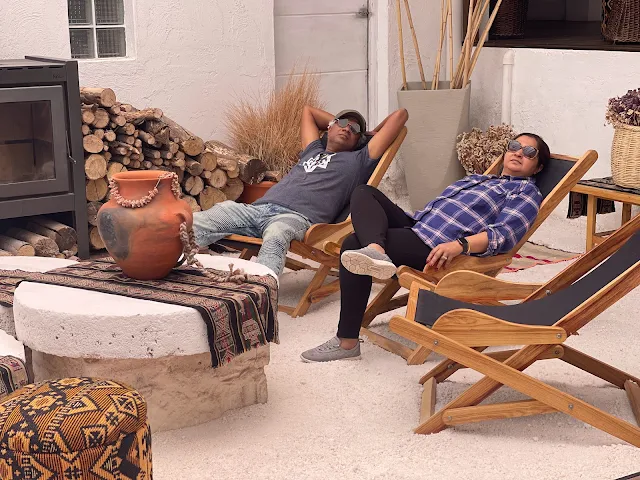







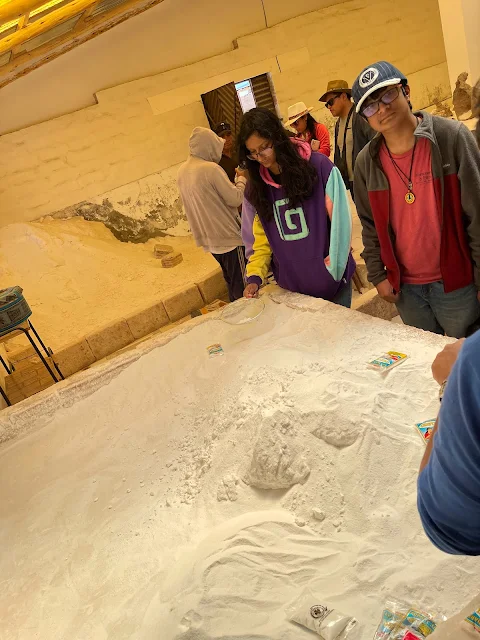




















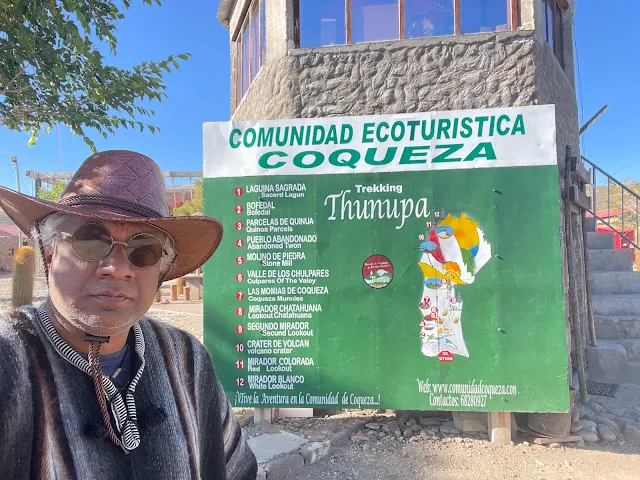

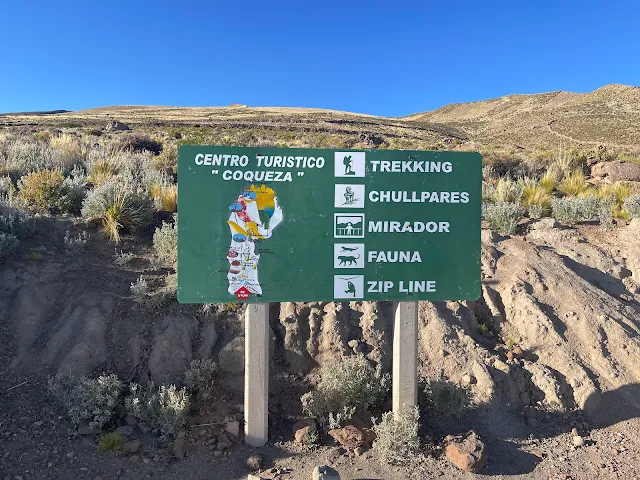
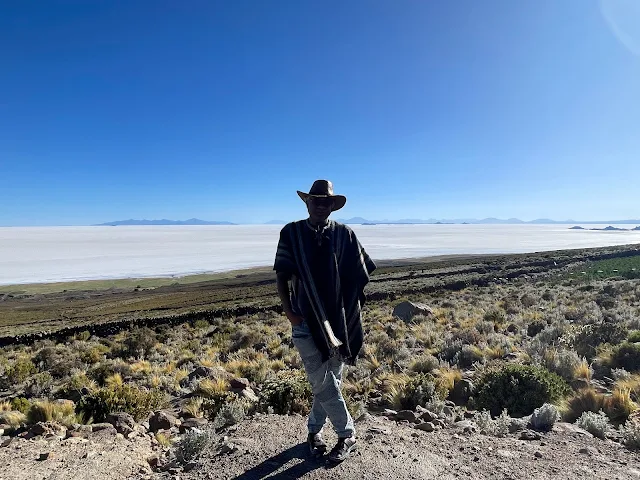






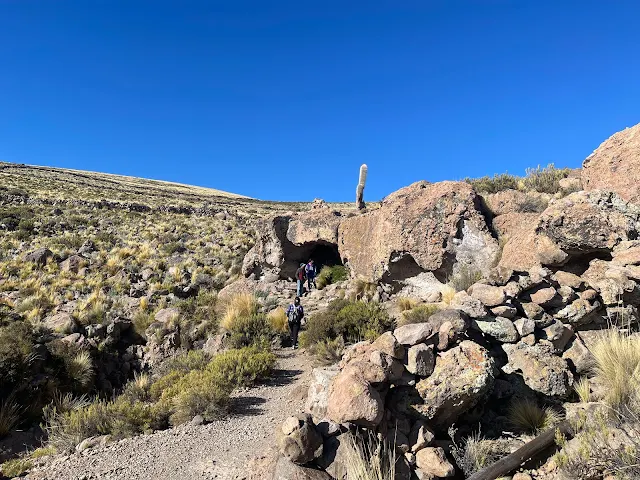




















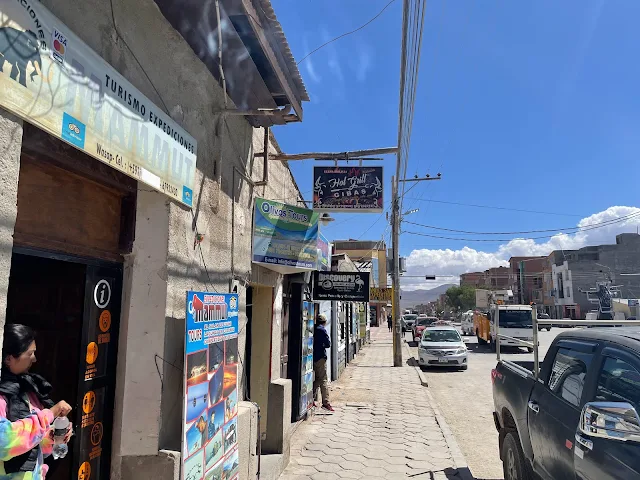












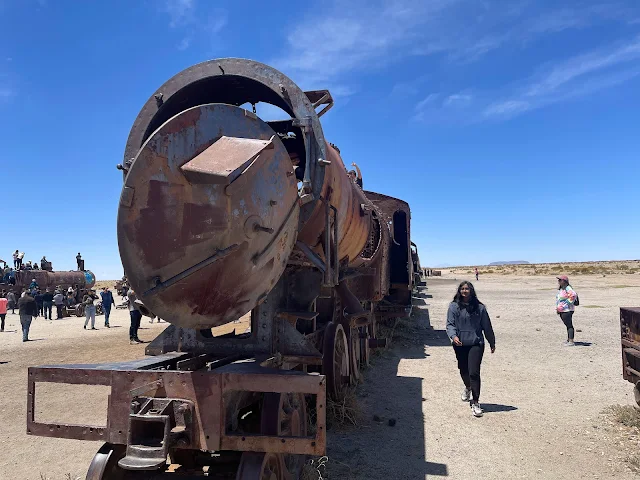

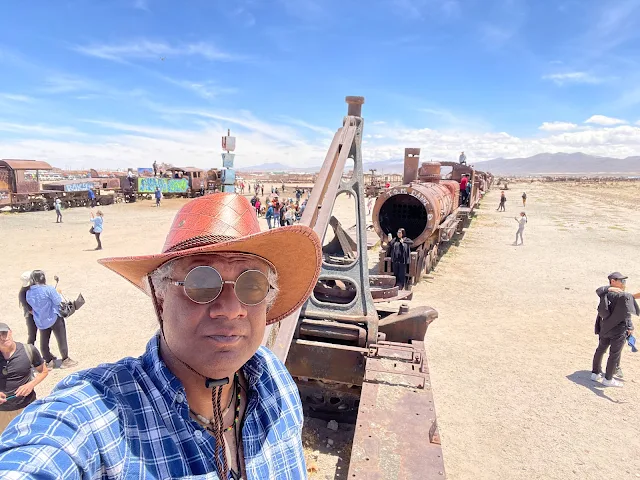





















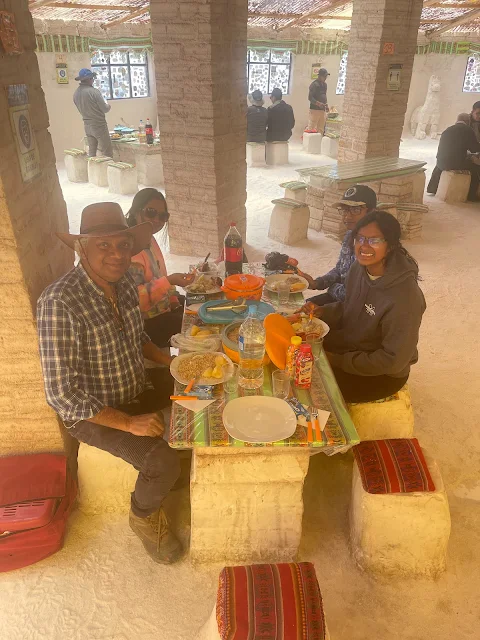


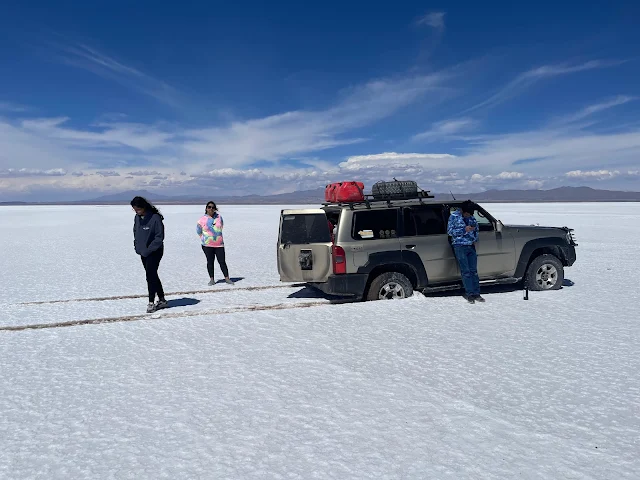







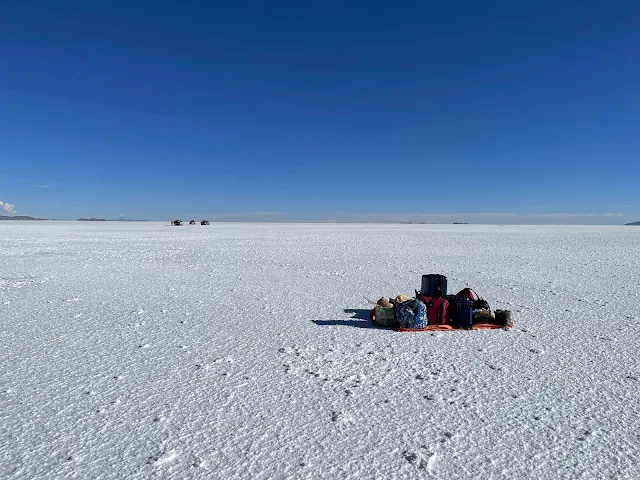


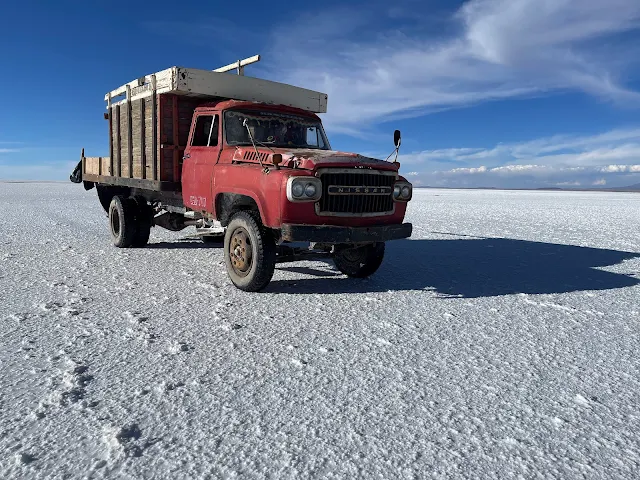





















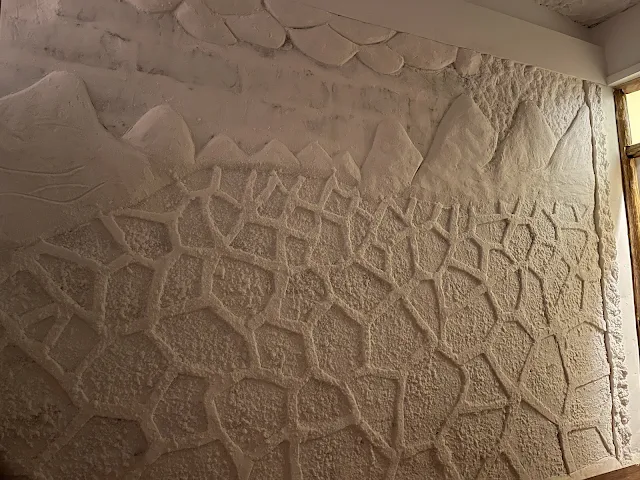





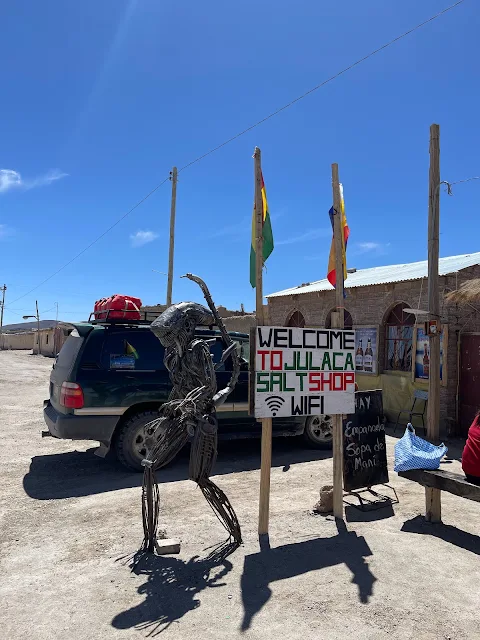


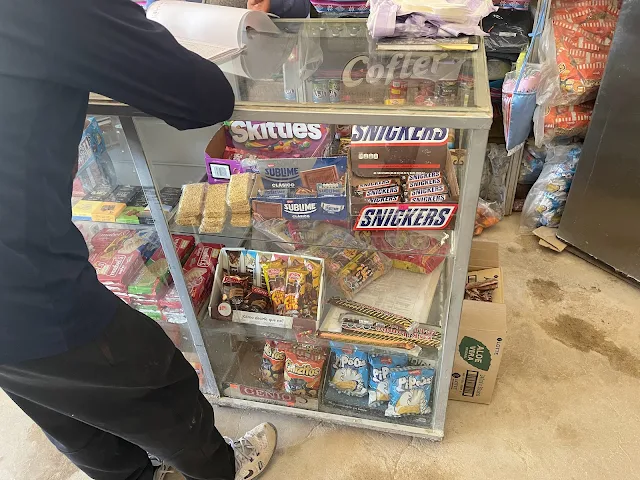
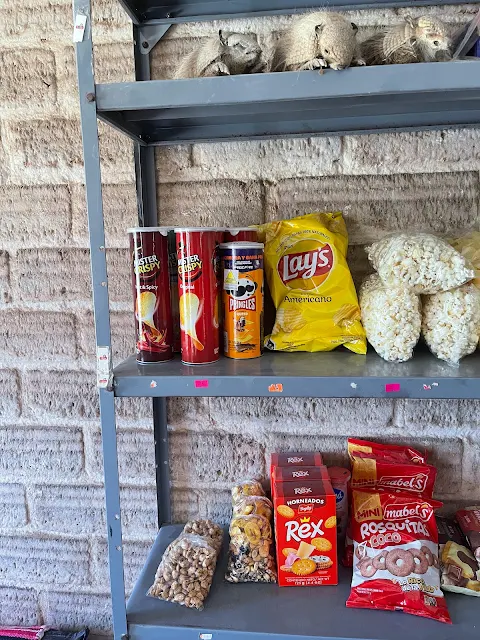






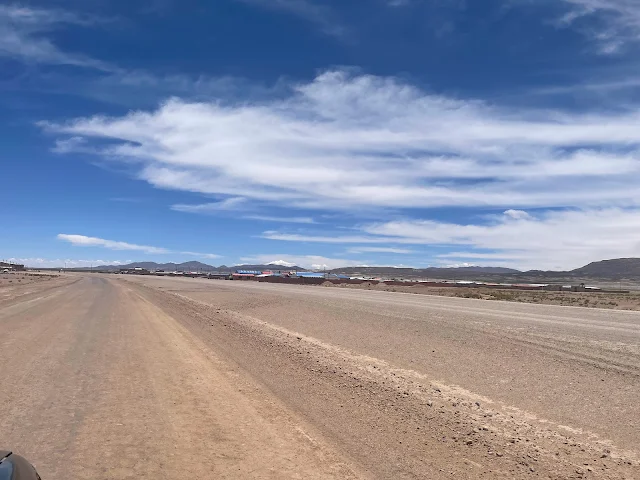




































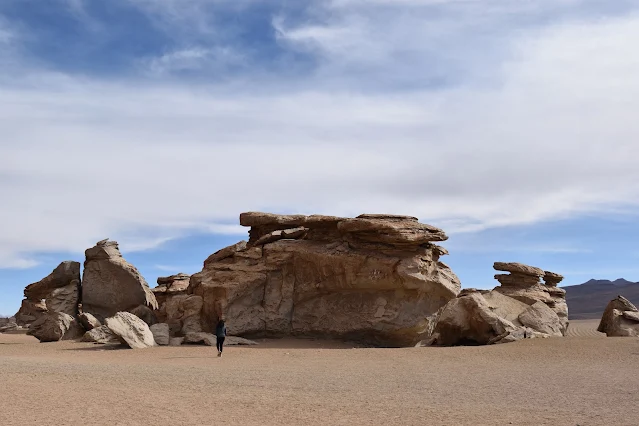








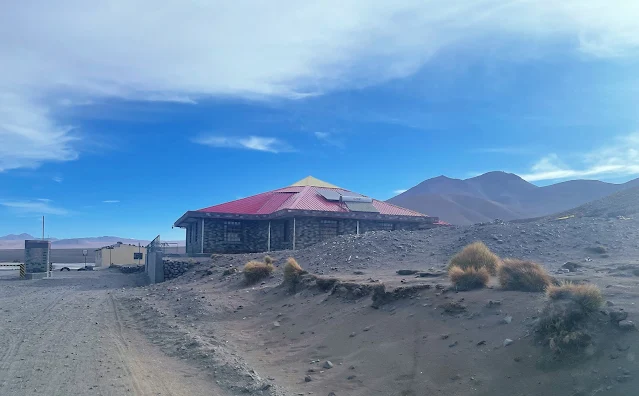





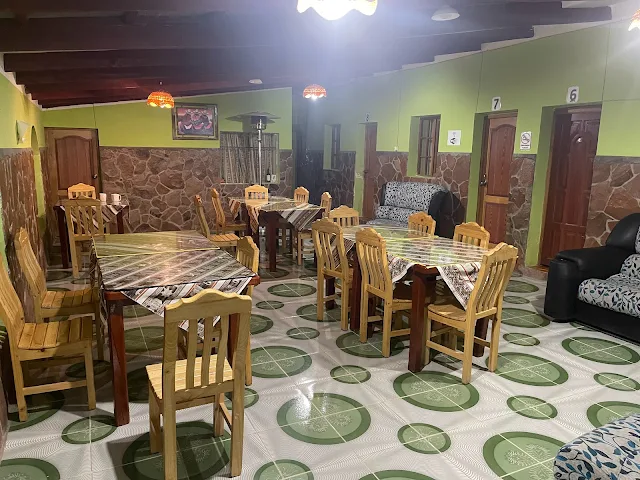
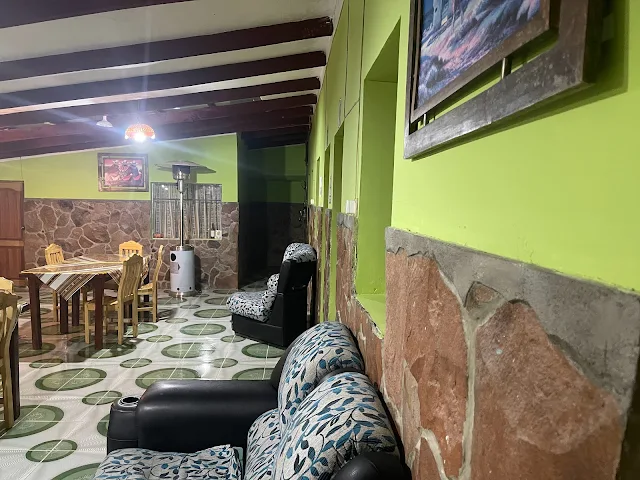



































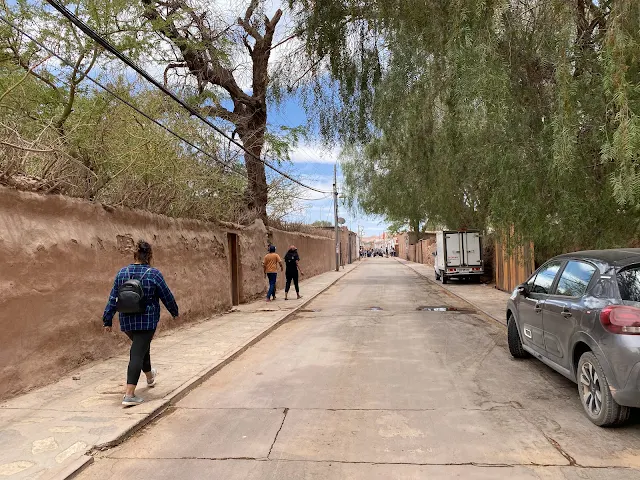






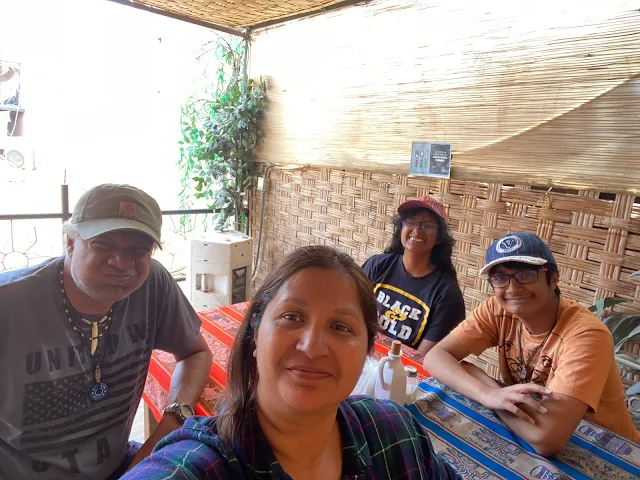





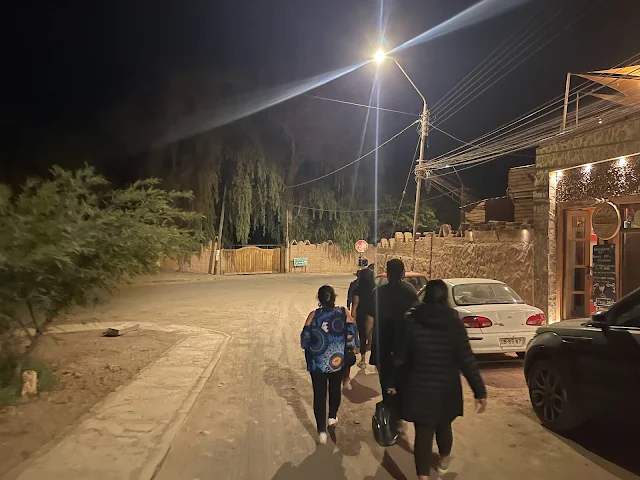






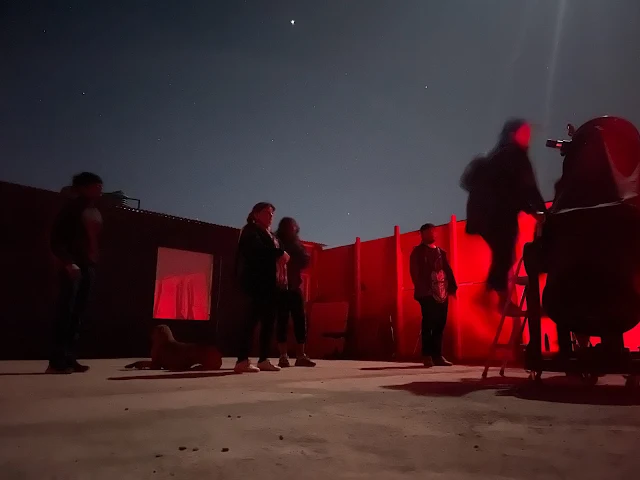



















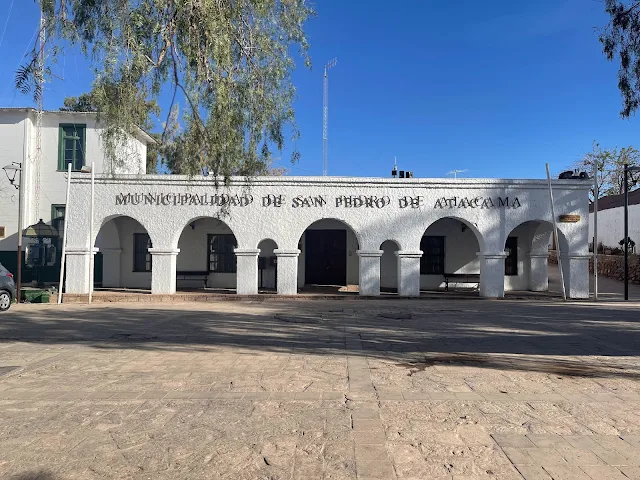









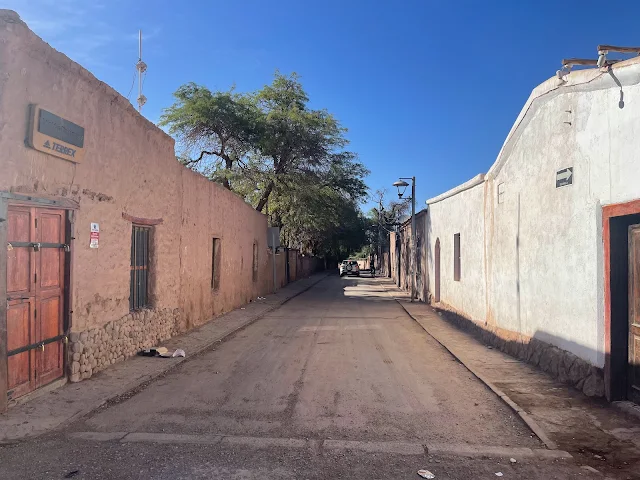





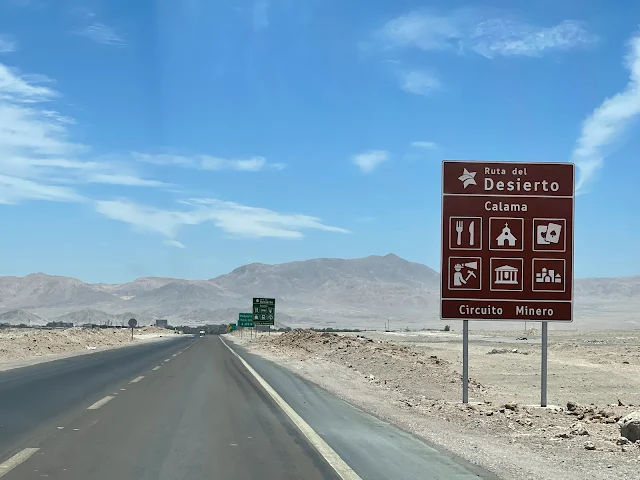
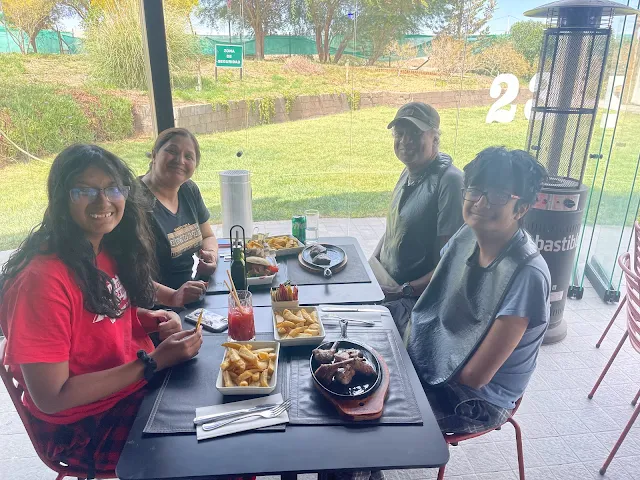



0 comments